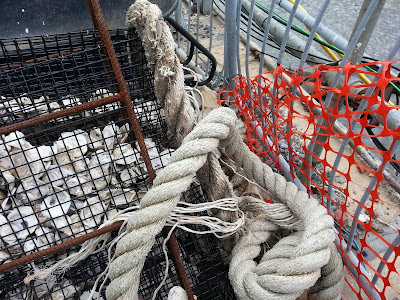The exhibition is open Fridays, weekends, and holiday Mondays from noon to 5pm every week until July 23rd.
Opening Reception is July 8th.
Check Harvestworks' site for further updates.
“Wave Crossings” is a soundscape/landscape created by Liz Phillips. Phillips has been recording sounds and exploring Governor’s Island and its history since 2014. The video is of fog rising one early morning over Governor’s Island. During a fog you can hear the foghorns, bell buoys and boat air horns of the New York Harbor. These sounds were discovered by Phillips on an old navigation map of Governor’s Island. The other recordings were made close to and under the water’s surface at the Billion Oyster Project’s dock. The telescope at the window picks up light changes from the sky and the moving leaves. In real time Phillips translates the telescope’s view into sound changes that create patterns in the wavetable. Other objects in the room act as filters and tactile speakers. Ultrasonic automatic focuses from cameras across the hallway entrance cause changes in the room’s sound based on the viewer’s presence and motion. The glass sphere shows the boats riding in Buttermilk Channel as we record in the morning fog.
One of Liz Phillips’s ongoing projects is to make installations based on her observations of different waterscapes. In “Here/Hear: Manhattan is an Island” (2010) Phillips worked with recordings made simultaneously around Manhattan Island. In “Spectral Reservoir” (2011) Phillips recorded the oceans around the Long Island Sound. In “Niagara Sound Composition 1974/2010” Phillips made recordings near Niagara Falls for the first exhibition of Artpark(1974) and the Albright-Knox Art Gallery(2010).
Liz Phillips has been making interactive multi-media installations for the past 40 years, which combine audio and visual art forms with new technologies to create an interactive sound experience. Born in New Jersey in 1951, Phillips received a B.A from Bennington College in 1973. She received the John Simon Guggenheim Fellowship in 1987. Phillips has made and exhibited interactive sound and multimedia installations at numerous art museums, alternative spaces, festivals, and public spaces. These include The Whitney Museum of American Art, the San Francisco Museum of Modern Art, the Spoleto Festival USA, the Walker Art Museum, Ars Electronica, Jacob’s Pillow, The Kitchen, and Creative Time, Stedelijk Museum, Gemeentemuseum Den Haag, Rene Block Gallery, Fredrieke Taylor Gallery. Phillips has also collaborated with the Merce Cunningham Dance Company, and her work was presented by the Cleveland Orchestra, IBM Japan, and the World Financial Center.
This project was made possible by Harvest Works, The New York State Council on the Arts, the David Bermant Foundation and Parabola Arts Foundation and by the recording, design and concept work of Andrew Russell, Annea Lockwood, Earl Howard, Eric Shekerjian, Isaac Zal Sprachman, Erica Vitucci, Frank Spigner, Heidi Howard, Kyla Raskin, Paula Rabinowitz, and Robert Scheuering.
Thank you to Carol Parkinson and all the interns at Harvestworks for their continued support on this project, Matthew Haiken of the Billion Oyster Project, and many other people working on to maintain this special space that is Governor’s Island.
When you get to the parlor of Buildin 7a in Nolan Park we invite you to sit in my mother’s circular garden chairs and listen and feel the sound.
Enjoy your ferry ride and visit!
Thank you!
Liz Phillips June 5, 2017
Robert Scheuering has created and maintained this blog http://lizphillipsgovsisland.blogspot.com/ for the Wave Crossings Project.































